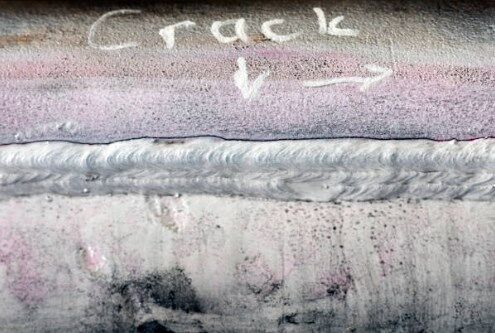Welding cracks are defined as fissures that occur in weld seams or the heat-affected zone (HAZ) during the welding process or after welding due to various factors. These cracks can significantly reduce the strength and durability of welded joints, potentially leading to structural failure. Therefore, it is crucial to understand the causes of welding cracks and the corresponding prevention measures to enhance welding quality and ensure safety.

I. Classification of Welding Cracks
Welding cracks can be categorized into four types based on their temperature of occurrence and location:
Hot Cracks: These cracks form at high temperatures during welding and are characterized by separation along the original austenite grain boundaries. Hot cracks can further be divided into crystalline cracks, liquation cracks, and multi-faceted cracks.
Reheat Cracks: These occur during post-weld heat treatment, often manifesting along the coarse austenite grain boundaries. Reheat cracks are predominantly found in steel varieties containing precipitation-hardening elements and high-temperature alloys.
Cold Cracks: These cracks develop at low temperatures after welding, typically along martensite or bainite grain boundaries or within the grains themselves. Cold cracks are commonly observed in high, medium carbon steels, low, and medium alloy steels in the HAZ, as well as in certain ultra-high-strength steels, titanium, and titanium alloys.
Layered Tear Cracks: These occur after welding due to insufficient ductility of thick plates to withstand the welding shrinkage strains in the thickness direction, forming step-like cold cracks in the base metal. Layered tear cracks are limited to the metals of thick plate base material or the HAZ of welds, often occurring in "L," "T," and "+" joint types.
II. Causes of the Occurrence of Welding Cracks
The origins of welding cracks are multi-faceted and include several primary factors:
Welding Stress: This refers to the stress generated during welding or post-welding due to the thermal input and output, which includes thermal stress and structural stress. Welding stress is a primary driving force behind crack formation; when it exceeds the crack resistance of the weld or HAZ, cracks develop.
Welding Distortion: This results from uneven heat distribution during welding or post-welding, including thermal expansion and contraction. Welding distortion can exacerbate welding stress and lead to uneven distribution, promoting the formation and growth of cracks.
Welding Microstructure: This describes the structures formed due to welding heat, including the weld metal and the metal in the HAZ. The type, morphology, distribution, and properties of the welding microstructure influence the occurrence of welding cracks. Generally, the more brittle, hard, and uneven the welding microstructure, the higher the likelihood of crack formation.
Welding Defects: These are flaws in the weld or HAZ that can arise due to various reasons during or after welding, including porosity, slag inclusions, lack of fusion, undercutting, and cracks. Such defects reduce the strength and toughness of the welded joint and can serve as sources or paths for crack propagation.
Welding Materials: These refer to the materials used during welding or after welding, including base metal and filler metal. The chemical composition, mechanical properties, physical properties, and weldability of these materials significantly affect the occurrence of welding cracks. Generally, the greater the amount of impurities, low-melting eutectics, and precipitation-hardening elements within the welding materials, the higher the risk of crack formation.
III. Preventive Measures Against Welding Cracks
Preventive measures against welding cracks are tailored to address the causative factors of these cracks. These measures primarily include:
Rational Welding Design: This involves carefully selecting welding methods, positions, sequences, and parameters based on the weld material’s weldability, the type of joint structure, and the stress conditions of the welded joint to reduce welding stress and distortion, prevent stress concentration, and enhance the crack resistance of the weld joint.
Suitable Welding Materials: This entails selecting appropriate base metals and filler metals based on their chemical composition, mechanical properties, physical properties, and weldability to decrease the brittleness and unevenness of the welding microstructure, reduce the content of impurities and low-melting eutectics, and enhance the compatibility and stability of the welding materials.
Effective Preheating and Post-heating: This refers to appropriately heating the welded areas before or after welding to lower the cooling rate of the weld, reduce welding stress and distortion, refine the welding microstructure, promote the escape of hydrogen, and improve the toughness and crack resistance of the weld area.
Strict Welding Operations: This means adhering strictly to welding designs and specifications during the welding process to guarantee welding quality, minimize welding defects, and prevent the formation and propagation of cracks.
Timely Welding Inspection: This involves promptly inspecting the welded joints after completion to detect any welding cracks and other defects. Early detection allows for immediate repair or replacement, thus preventing the expansion of cracks and ensuring the structural integrity and safety of the welded assembly.
IV. Summary
Welding cracks are a common defect that can significantly impair the performance and safety of welded joints. They are classified into hot cracks, reheat cracks, cold cracks, and layered tear cracks, each with distinct causes and preventive measures. This article has outlined various strategies to minimize the occurrence of welding cracks, focusing on material selection, welding design, welding practices, and inspection protocols.
By understanding the root causes of welding cracks and actively implementing these preventive measures, the quality and safety of welding processes can be significantly enhanced. Ensuring strong, resilient welds not only promotes structural reliability but also contributes to the overall longevity and performance of welded components in various applications.
Related articles:
1. Welding Hot Cracking, Reheat Cracking, Cold Cracking & Tearing
2. How To Weld Cast Iron And Avoid Weld Cracking?
3. How to Avoid Weld Cracking in High-strength Aluminium Alloys?
4. How do welding defects (pores, undercuts) affect weld joints?
5. How to Identify the 7 Most Dangerous Welding Defects?




